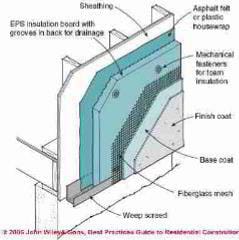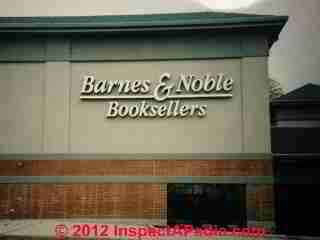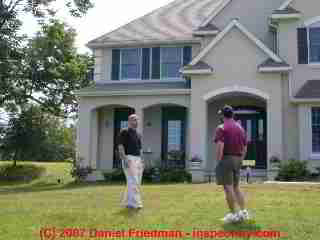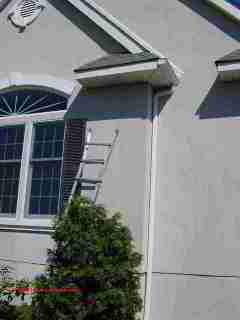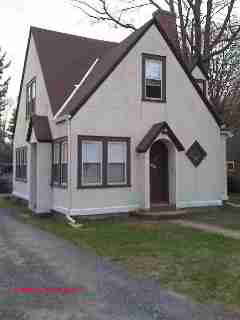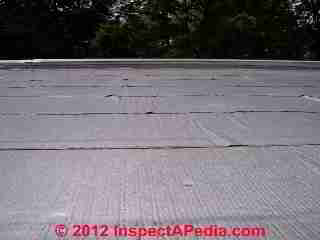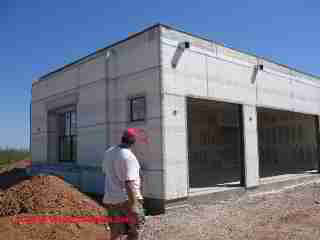 Exterior Stucco & EIFS Stucco Wall System
Exterior Stucco & EIFS Stucco Wall System
Stucco
installation, inspection, diagnosis, repair
- POST a QUESTION or COMMENT about stucco wall coatings: types, installation, cracks, diagnosis, & repair
Stucco & EIFS synthetics stucco wall construction, inspection, troubleshooting, repair guide:
Here we describe the inspection, diagnosis, repair, and proper installation of both traditional stucco building wall surfacing and synthetic stucco EIFS systems.
We describe traditional and synthetic stucco; we review the use of weather barriers on building walls beneath stucco coatings. Our page top photo shows the Gieseke residence under construction and being prepared for a stucco exterior wall application. The building is located in Arizona, in the USA.
InspectAPedia tolerates no conflicts of interest. We have no relationship with advertisers, products, or services discussed at this website.
- Daniel Friedman, Publisher/Editor/Author - See WHO ARE WE?
Synthetic Stucco, EIFS Siding Products, Failures, Litigation, Services
EIFS is an abbreviation for "Exterior Insulation and Finish Systems" or "barrier", a synthetic stucco material which is usually applied over a system of solid foam insulation board and synthetic fabrics to form a stucco building exterior surface.
[Click to enlarge any image]
There have been substantial building failures and costly damage at many EIFS covered buildings, primarily because the EIFS-covered building exterior may leak into the building walls but the foam insulation used beneath this stucco method may not allow moisture to escape from building cavities.
We discuss stucco installation, troubleshooting, repairs, leaks, painting and other related topics.
EIFS Wall Construction Photos & Details
Below we illustrate the construction of an EIFS barrier wall - on a Barnes & Noble bookstore being built in Poughkeepsie, NY (1999).
The workers are nailing solid styrofoam board to the plywood building sheathing. On walls with few penetrations (below right) or other opportunities to make an installation mistake, EIFS has performed well (in our OPINION).
Common Causes of Leaks in EIFS Walls
Our page top photo shows the Gieseke home under construction in Tucson, AZ in 2007. Here is a photo of the completed structure. Below are photos of New York EIFS-clad home that we inspected after the owner complained of chronic leaks into the structure.
At below right was one of quite a few leak points we found. We confirmed actual leakage at these faults by a gentle mist-spray from a garden hose, simulating rain.
This home typified the EIFS leak and hidden damage problem: a conceptually sound barrier wall design won't function properly if it is too vulnerable to errors during construction or damage afterwards.
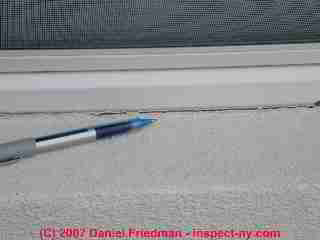
In a nutshell, while stucco on building exteriors is a very old technology with centuries of success, even of limited wall leak tolerance, leaks into the structure of an EIFS-covered building can cause major mold, rot, and structural damage because water leaks into the structure from installation defects (very common), holes, or damaged siding.
EIFS synthetic stucco product manufacturers provide detailed installation guides that should be meticulously followed by builders. EIFS manufacturers state that if their materials are installed according to their specifications there will not be problems with this synthetic stucco method.
But we have rarely found a residential building at which the demanding and detailed product specifications have been followed during installation, and in our OPINION, the specifications may be just too demanding for many residential EIFS installers. EIFS siding material has been the subject of failures and litigation.
The photographs above are of an EIFS building exterior showing the attractive EIFS finish in the left photo and a typical wall leak at an improperly installed window sill in the right-hand photo. Further invasive inspection found rot and damage in building walls at multiple locations where penetrations or absent flashing or caulking had led to leaks.
Our photo (left) shows an inspection point on a recently-constructed EIFS sided building. While the wall looked great from outside, inside the building. this wall cavity was wet and moldy. We were surprised to find wind-blown leaks just under the eaves of the soffit overhangs where the manufacturer-recommended backer rod and sealant had been omitted..
At another EIFS building we investigated and one which was in litigation, the EIFS installation contractor defended a defective EIFS installation (no caulking, no sealants, no flashing) by arguing that the prime contractor was responsible for those details and that his contract excluded those details.
He was "just hired to apply the stucco system". In view of the fact that "application" of the particular manufacturer's stucco system called for numerous sealing details, not one of which was followed, this was a ridiculous argument. Damages were substantial.
EIFS, Synthetic Stucco, Dryvit, Sto wall type system failure investigations, EIFS leaks, building rot from siding leaks, EIFS defects-caused mold damage, EIFS siding inspection and repair methods are discussed at the links to articles, attorneys, associations, and product manufacturers listed at this website.
EIFS Performance & Background
The EIFS schematic above is provided courtesy of Steven Bliss & J Wiley & Sons [13] and illustrates the layers in a typical EIFS installation and is detailed further
at STUCCO EIFS DRAINAGE SYSTEMS. [Click this or any of our images to see an enlarged, detailed version.]
Williams & Williams provide a thorough description of EIFS, its components, and its design principles in their contributions to Water in Exterior Building Walls [12], a useful text on that topic - excerpting & adapting:
Composite nature of EIFS:
EIFS claddings are barrier walls that are intended to shed exterior water, stop water intrusion, and keep the building interior dry. EIFS are highly integrated composite systems. [EIFS walls] incorporate several material layers: finish coat, base coat, reinforcement, and insulation board.
See WALL CONSTRUCTION BARRIER vs CAVITY
EIFS coatings and reinforcement are applied to rigid insulation board that has been attached to the building substrate. To achieve proper system functioning, system materials are assembled to create a single, unified barrier in which all components act as one.
Key role of the EIFS Lamina:
The primary EIFS barrier against water intrusion is the lamina, consisting of finish and base coats together with system reinforcement.
The lamina acts as a waterproofing layer between the outside of the building and the insulation board. The base coat is the component most responsible for moisture protection. Its acrylic polymer constituents coalesce upon drying and form a continuous matrix capable of resisting water intrusion.
The base coat also imparts flexibility to the system and resists cracking, with the aid of embedded fiberglass mesh. ... Defects that originate in the lamina or develop in the lamina as a result of other system deficiencies can threaten the water-tight conditions essential to a properly functioning EIFS barrier wall.
This is of particular concern when the EIFS barrier claddings are adhesively attached to paper-faced gypsum substrates.[12].
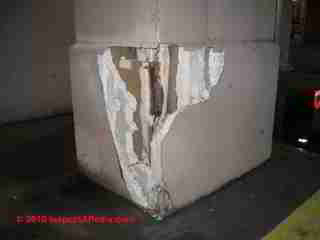
Our EIFS damage photograph shows how water or moisture traps can form in an EIFS wall even in a building interior, leading to substantial damage where an "EIFS" system was applied over paper faced gypsum substrate referred to by Williams & Williams above.
(Photograph courtesy of home inspector John Rudy [14]).
As detailed at STUCCO WALL METHODS & INSTALLATION and in the printed text Best Practices Guide to Residential Construction (Steve Bliss, J Wiley & Sons)
When originally imported from Europe to the United States in the 1970s, most exterior insulation and finish systems (EIFS) were “barrier” type systems. They were designed to create a waterproof exterior skin consisting of a thin layer of acrylic polymer-based synthetic stucco directly applied to foam insulation.
The expanded polystyrene
(EPS) foam was glued to the building’s sheathing.
A layer of fiberglass cloth embedded in the synthetic
stucco provided reinforcement, and a thin acrylic finish
coat added color and texture.

With the EPS glued directly to the sheathing, there was no place for building paper or conventional flashings at penetrations. Openings, joints, and penetrations relied on caulks and sealants for waterproofing. With no backup waterproofing or drainage layer, there was little margin for error.
While these systems performed adequately in Europe for nearly 25 years, the United States version had thinner base coats and lower polymer content, creating a weaker skin. Also, workmanship in the United States was often inferior due to lack of applicator training and quality-control programs.
When water leaked into these systems through failed caulk joints, cracks in the stucco skin, or through the window frames themselves, it wet the foam insulation, sheathing, and sometimes the structural framework.
The water running down the building interior wall (photo above left) was traced to omission of the manufacturer-specified sealant methods at the top of the building exterior wall. Wind-blown rain entered the wall top just below the soffit overhang, wet the wall interior cavity, and finally appeared on the foundation walls below.
At our photo guide to some common leak points found on EIFS clad buildings SIDING EIFS WALL LEAK POINTS, one of our our EIFS leak point photographs shows a leaky window detail at an EIFS-clad building in New York.
This installation error in turn led to more sealant failures and cracking of the surface and additional leakage. The EPS foam acted like a sponge, trapping water against the building, and the nonporous polymer coatings retarded drying. In many cases the leakage and resulting decay was extensive, resulting in widespread property damage and litigation.
Use of peel-and-stick membranes as waterproofing under stucco wall covering?
Reader question: In various areas of house having to be re-stuccoed, I.e. at various walls sections, where wall intersects with roof, at chimney, the contractor has used peel-and-stick membrane (boral protectowrap, as used in underlayment for re-roofing), to cover whole sections of walls for waterproofing beneath the newly, reapplied stucco.
Question 1: I am concerned with any problems in using this roofing material for waterproofing in the walls.
We are located in Northern Florida, Ponte Vedra Beach, and concerned with the hot, tropical climate this waterproof membrane may create an barrier inside the wall, leading to problems with moisture and wood decay within the wall cavity. Most of the wall areas are stucco, one masonry.
Question 2: I understand there are similar peel and stick products developed specifically for wall against water intrusion, but the contractor used the same peel and stick from the roofing for our walls. Is this an issue?
Thank you! Homeowner - 7/19/2012
Reply:
A competent onsite inspection by an expert usually finds additional clues that help accurately diagnose a problem with building leaks and moisture and with stucco wall-covering application. That said,
I'm a little confused about your question as you say that the contractor used a peel-and-stick waterproofing membrane "at various walls sections, where wall intersects with roof, at chimney"
and later "to cover whole sections of walls for waterproofing beneath the newly, reapplied stucco"
Housewrap Products Designed Specifically for Use Under Stucco Wall Coatings
The traditional moisture barrier used beneath exterior wall stucco was building paper or roofing felt. [9]
See FELT 15# ROOFING, as HOUSEWRAP/VAPOR BARRIER
On the new-construction stucco covered exterior walls that I've inspected the usual procedure has been to cover the wall with a housewrap designed for use under stucco.
The wrap is water proof but not moisture proof, keeping water out of the wall but allowing moisture in the wall to escape. In the trade lingo these are called "weather resistive barriers (WRBs) and they are intended to prevent water from leaking into the wall sheathing or wall cavity. There are a number of building standards intended to address the resistance of wall finish systems to leaks and water penetration.
- StuccoWrap:
An example of a housewrap specifically designed for use under stucco is StuccoWrap, a non-woven polyolefin fabric with a perm rating of 50.0 and designed for use under both traditional and synthetic stucco wall applications. The product may reduce stucco cracking because it does not itself absorb water nor expand or contract.
This is a Tyvek product that is designed for stucco or masonry wall applications. It includes a corrugated surface and is compatible with the chemicals in stucco.
Those chemicals might react with other housewrap products; we have not found an authoritative citation evaluating the use of smooth or rough zero-perm peel and stick membranes in that application. [7][8] - DuPont™ Tyvek® CommercialWrap® D
is also recommended for use under stucco and is designed to work with both traditional stucco and synethetic stucco products. It too uses a grooved surface to improve drainage as part of synthetic or EIFS stucco systems.[10]
We do use zero-perm peel-and-stick membrane tapes regularly around windows and doors in exterior walls, as you can review
at FLASHING MEMBRANES PEEL & STICK.
Peel & Stick Membranes under Stucco Wall Coatings?
Note that while StuccoWrap has a perm rating of 50 and other housewrap products also are moisture permeable, the perm rating of peel and stick membranes is generally close to zero.
In some climates such as in northern areas where there is a significant heating season, putting a zero-perm barrier on the outside of the wall under the finish wall covering is asking for trouble with future wall cavity condensation and leaks or rot
See VAPOR BARRIERS & CONDENSATION in buildings
and VAPOR BARRIERS & HOUSEWRAP
Our photo (left) shows a granule-coated peel-and-stick roof membrane during metal roof installation. The peel-and-stick membrane shown is waterproof and protected the building for several weeks while waiting for the metal roof to arrive. It is a roofing product, not a wall product.
Photo courtesy Galow Homes.
In your area, Florida, where the climate is hot and very humid, it is imaginable to place the peel-and-stick zero perm vapor barrier on the exterior side of the building exterior walls to avoid moisture condensation within the wall cavity when the home is air conditioned and thus cooled inside.
See STUCCO WAll FAILURES DUE TO WEATHER but there may be other issues about drainage, drying, curing, etc. on which your stucco system manufacturer would have a say.
Peel and stick roof underlayments
In the humid South, the peel-and-stick membrane products used on roofs as a roofing underlayment might work acceptably under stucco in that any fasteners driven into the wall to support whatever method is being used to support the stucco itself (wire mesh? foam?) will be sealed where driven through the sticky membrane.
See details at UNDERLAYMENT REQUIREMENTS on ROOFS
And some products such as shown in our photo (of a not so hot installation on a low slope roof) include grooves that might assist drainage.
Peel and stick foundation wall & specialty water barriers
The peel-and-stick vertical surface or "wall" waterproofing membranes on the market usually indicate that they are designed for use below grade level as an improvement in foundation waterproofing.
None of these that we reviewed described the use of the product under above-ground stucco-covered walls. Some examples:
- NUDURA® Damproofing/Waterproofing Membrane [5]
- Jiffy Seal® 140/60 60 mil, polyester reinforced, peel and stick sheet waterproofing. Quoting:
... for use on foundation walls, decks, balconies, bathrooms, terraces, split slabs, parking structures and anywhere a positive waterproofing membrane may be needed. [4]
A principal difference I've observed between the two peel-and-stick roof vs vertical wall products (by eye, not any chemical test) is that roof-use peel and stick membranes are thicker (more than 1mm) and include a roughened surface principally to help prevent workers from slipping and sliding down off of the roof during installation.
That coating may also provide some durability during temporary weather exposure as on some projects roofers dry-in the building with peel-and-stick over the whole roof while waiting for specialty roofing products to arrive at the jobsite, sometimes weeks later.
Both product types, roof and wall, are intended to be absolutely waterproof if installed as directed.
More Housewrap Details & Choices are
at HOUSEWRAP AIR & VAPOR BARRIERS
Bottom line:
You did not indicate what type nor product brand of stucco is being installed on your home, nor whether local building permits and code compliance inspections are being applied.
See STUCCO WALL METHODS & INSTALLATION
If I were the builder or onsite investigator, I'd find out what stucco system and product was being installed, and then I would both review the stucco's installation instructions and their specifications for the housewrap or weather barrier called-for beneath their product.
Usually these specifications are very extensive, detailed, and sometimes not fully followed, and I would contact the stucco product manufacturer directly to ask their advice.
To approach this topic from the top,
If your stucco on foam siding extends below ground, also see INSECTS & FOAM INSULATION.
Stucco Research
- Huffman, Ron & Dennis ROse, "You've Identified Stucco! What Else Should You Know?" [PDF] (2009), InspectionWorld Orlando Conference, January 21-24, 2009, ASHI American Society of Home Inspectors
- See more references and citations atReferences or Citations below
...
Continue reading at STUCCO EIFS DRAINAGE SYSTEMS or select a topic from the closely-related articles below, or see the complete ARTICLE INDEX.
Or see these
Stucco Finish System Articles
- CONCRETE STAINS: ID & REMOVAL
- GRAFFITI REMOVAL FROM BRICK CONCRETE STONE SURFACES
- HOUSEWRAP AIR & VAPOR BARRIERS
- INSECTS & FOAM INSULATION
- PAINT FAILURE, DIAGNOSIS, CURE, PREVENTION - home
- SIDING EIFS & STUCCO - home
- PAINT on STUCCO, FAILURES
- SIDING EIFS STUCCO PAINT FAILURES
- SIDING EIFS WALL LEAK POINTS
- STUCCO & CONCRETE BONDING AGENTS
- STUCCO EIFS DRAINAGE SYSTEMS
- STUCCO, HARD COAT INSTALLATION, INSPECTION, REPAIR
- STUCCO OVER FOAM INSULATION
- STUCCO WAll FAILURES DUE TO WEATHER
- STUCCO WALL METHODS & INSTALLATION
- STUCCO RECIPES & APPLICATION
- STUCCO THIN COAT APPLICATION
- STUCCO WALL WEEP SCREED DRAINAGE
- SIDING LEAK DIAGNOSIS & REPAIR
- SIDING TYPES, INSTALLATION, DEFECTS
- STONE, STUCCO & BRICK CLEANING METHODS
- VAPOR BARRIERS & HOUSEWRAP
Suggested citation for this web page
SIDING EIFS & STUCCO at InspectApedia.com - online encyclopedia of building & environmental inspection, testing, diagnosis, repair, & problem prevention advice.
Or see this
INDEX to RELATED ARTICLES: ARTICLE INDEX to EXTERIORS of BUILDINGS
Or use the SEARCH BOX found below to Ask a Question or Search InspectApedia
Ask a Question or Search InspectApedia
Try the search box just below, or if you prefer, post a question or comment in the Comments box below and we will respond promptly.
Search the InspectApedia website
Note: appearance of your Comment below may be delayed: if your comment contains an image, photograph, web link, or text that looks to the software as if it might be a web link, your posting will appear after it has been approved by a moderator. Apologies for the delay.
Only one image can be added per comment but you can post as many comments, and therefore images, as you like.
You will not receive a notification when a response to your question has been posted.
Please bookmark this page to make it easy for you to check back for our response.
IF above you see "Comment Form is loading comments..." then COMMENT BOX - countable.ca / bawkbox.com IS NOT WORKING.
In any case you are welcome to send an email directly to us at InspectApedia.com at editor@inspectApedia.com
We'll reply to you directly. Please help us help you by noting, in your email, the URL of the InspectApedia page where you wanted to comment.
Citations & References
In addition to any citations in the article above, a full list is available on request.
- Eric Galow, Galow Homes, Lagrangeville, NY. Mr. Galow can be reached by email: ericgalow@gmail.com or by telephone: 914-474-6613. Mr. Galow specializes in residential construction including both new homes and repairs, renovations, and additions.
- Mark Cramer Inspection Services Mark Cramer, Tampa Florida, Mr. Cramer is a past president of ASHI, the American Society of Home Inspectors and is a Florida home inspector and home inspection educator. Contact Mark Cramer at: 727-595-4211 mark@BestTampaInspector.com 11/06
- Arlene Puentes [Website: www.octoberhome.com ] , an ASHI member and a licensed home inspector in Kingston, NY, and has served on ASHI national committees as well as HVASHI Chapter President. Ms. Puentes can be contacted at ap@octoberhome.com
- In addition to citations & references found in this article, see the research citations given at the end of the related articles found at our suggested
CONTINUE READING or RECOMMENDED ARTICLES.
- Carson, Dunlop & Associates Ltd., 120 Carlton Street Suite 407, Toronto ON M5A 4K2. Tel: (416) 964-9415 1-800-268-7070 Email: info@carsondunlop.com. Alan Carson is a past president of ASHI, the American Society of Home Inspectors.
Thanks to Alan Carson and Bob Dunlop, for permission for InspectAPedia to use text excerpts from The HOME REFERENCE BOOK - the Encyclopedia of Homes and to use illustrations from The ILLUSTRATED HOME .
Carson Dunlop Associates provides extensive home inspection education and report writing material. In gratitude we provide links to tsome Carson Dunlop Associates products and services.


